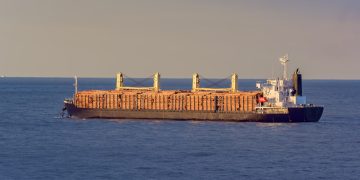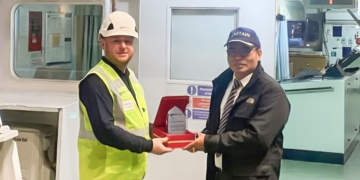This time, our special column, in association with The North of England P&I Club, gives emphasis on safety performance. Today, shipping industry should be able to measure real safety performance. For this reason, focus on measuring and assessing performance is necessary, as it will provide ways to develop and manage challenges successfully. Eventually, measuring safety performance accurately, will give a clearer picture of how the industry is doing things. In this regard, we asked global experts to share their views on the following question:
Is the maritime industry measuring its safety performance effectively?
 Alvin Forster Deputy Director (Loss Prevention) The North of England P&I Club |
 Erwin Derlagen COO, Enesel Limited |
|
| No. The most common methods of measuring safety tend to focus on ‘lagging indicators’, which is basically looking into past performance. Typically this measures how many fatalities, injuries or near-misses have been reported (which is not necessarily the same as how many have actually occurred) and ultimately producing a statement of how many days have been “LTI-free”. In an open and just culture, these measures remain very valuable. But if a culture exists where reporting is feared (either through fear of retribution or not wanting to be the one that breaks their proud “LTI-free” record), then these measures don’t paint the real picture of what actually happens on board. Its time to complement this with measuring ‘leading indicators’ which provide an indication of the safety culture – both on board and ashore. Organisational safety culture assessments – such as North’s SCORA initiative (https://www.nepia.com/scora/) are examples of how you can measure the real safety performance. | Unfortunately we are not! In respect of crew incidents, we use as a basis of investigation statistics of injuries or, worse, fatal accidents, whereas the focus of any inquiry should be the root cause of each and every incident, in other words “why” something happened. In respect of machinery breakdowns, it is virtually impossible to get information on what caused the problem and this is so especially on modern vessels. Equipment today is designed to meet the “highest Class requirements”. This admittedly sounds nice, however, in practice it actually means “minimum requirements”, using modern design CAD software, calculating and meeting “spot-on” those minimum requirements. The “safety” margin was once empirically agreed upon and comes from another non-computerized era. We need to have a fresh look from the start and design robust equipment, which is not unforgiving and will not hurt our mariners, with proper safety margins. | |
 Capt. Joel Ian Ayos Manning Manager, Döhle Seafront Crewing Manila, Inc. |
 Capt. Mark Bull FNI Marine Consultant, Trafalgar Navigation |
|
| Yes, safety performance is being measured effectively. The big question is not the measurement but the accuracy of the data. The issue is more about the compliance with safety. The industry has implemented various rules and regulations which has been studied and reviewed overtime. Safety checklists and permits are in in place, monitored, and measured properly. However, are these reports true and accurate or these are just numbers to impress prospective clients? Transparency, support, motivation, teamwork – these are what we need. Transparency to expose the truth of what is really happening onboard and ashore. Support from all offices to fill-in this gap. Motivate everybody to make a difference by making things better. Teamwork where everybody is working together to achieve a common goal; the safety of the people, of the environment, and of the ship. | “NO” This answer is simple. Did we not establish the ISM Code more than 20 years ago now as a leading indicator for marine safety. So where are the numbers? Where are the annual totals of Non Conformities issued and under what category? Is there any benchmarking Non Conformities under ship type? Are the same Non Conformities being repeated? Is anybody the connection between specific accidents and specific elements of the Code?Every accident or incident since the introduction of the Code is a failure of the Code itself. How can we report on the effectiveness of the Code if we have no numbers? Welcome big data! | |
 Capt. Atul Vatsa Vice President, Head of Compliance, Head of Marine & Safety Thome Group (Singapore) |
 Stavros Meidanis DPA/CSO, S&Q Manager, Capital Ship Management Corp. |
|
| Yes. Safety performance is effectively and collectively measured via the standard maritime codes using hardware and software tools. The Maritime code, which covers ISO, ISM, IMO circulars, rules, regulations, lifestyle and cultural assessments, is recognized as an efficient process to measure safety performance and has helped steadily improve it over the past few decades. In an organisation there are many tools for working safely and effectively such as safety barriers, a safety culture and procedures which reflect the latest maritime standards. Above all, the most important asset of any maritime organisation is well trained and competent seaman and officers on board.
Yes – Well trained. This is driven by operational excellence, training and a positive attitude towards safety culture. Though they are competent, humans tend to make mistakes. Not intentionally, but mistakes are made on a daily basis. Our industry is not free from human error. Training and seminars can be developed based on leadership excellence, risk management, behaviour based safety, learning and development to adjust behaviour and minimise mistakes. Safety equipment needs to work and be properly maintained because its Safety Critical and not PSC / SIRE Critical. It is crew members’ lives at stake when an emergency occurs and properly working safety equipment will help them in handling a crisis effectively. Safety should not just be a checklist exercise but taken seriously as safety procedures are there to save lives and protect assets. Regular monitoring and effective training can enrich the fleets’ own performance and provide benchmarking capabilities. A change of mindset is vital and necessary for seafarers. On board discussions and collaboration to facilitate a higher degree of safety known as “cultivators” is important. Assessment and evaluation are mandatory to reflect the individual personalities towards a safer future in the maritime industry. |
No. Shipping companies set strategies in order to reach objectives measuring its safety performance. In return, they develop and follow processes in order to realize strategies through the achievement of objectives – and of course, this is a never ending cycle. Shipping Industry is changing rapidly. New technologies and innovation are adopted and implemented onboard vessels. However, the critical question remains – do we monitoring safety performance effectively. Without the use of the modern tools and technologies, will not be possible to cope with new requirements and challenges for shipping sector. Artificial Intelligence (AI), Big Data, Business Analytics and Digitalization, should be the key factors to measure safety performance effectively and at the same time to comply with new rules and regulations.
We have to keep in mind that all the above are necessary tools for decision makers. It is widely accepted that effective safety performance measurement should provide decision makers with information, models and analysis with regards to how well the various objectives are being achieved. Shipping Companies should have two obstacles when making optimal decisions regarding company’s objectives. The first is that the shipping industry is complex and the complexity lies in its high cyclicality, volatility and unpredictability. The second, involves the human capacity to process information; the rationality of human decision-making is bounded and humans make decisions on the basis of selective information. |
|
 Katerina Skourtanioti Katerina SkourtaniotiManaging Director at VENLYS, Maritime Specialisation Services |
||
| ΜΑΥΒΕ. Replying to the specific question may turn to be anything than a trivial task. The truth is that an ‘easy’ reply would be simply stating YES, MAYBE, or NO. Of course reality is NEVER so simple or so clear. The safety performance of the maritime industry includes so many things and if somebody adds the term effectively then the complexity of the topic increases significantly. Safety performance of the ship? Safety performance of the procedures? Safety performance of the human element (mainly crew but also shore personnel)? Safety performance of the overall system? What is the safety performance of the maritime industry? Number of incidents/accidents? Can it be something that simplistic? Is being compliant enough? How safe is safe? Can we assess whether this is done effectively? This is a highly non linear and multi attribute problem. So a safe reply can be MAYBE! | ||


































































